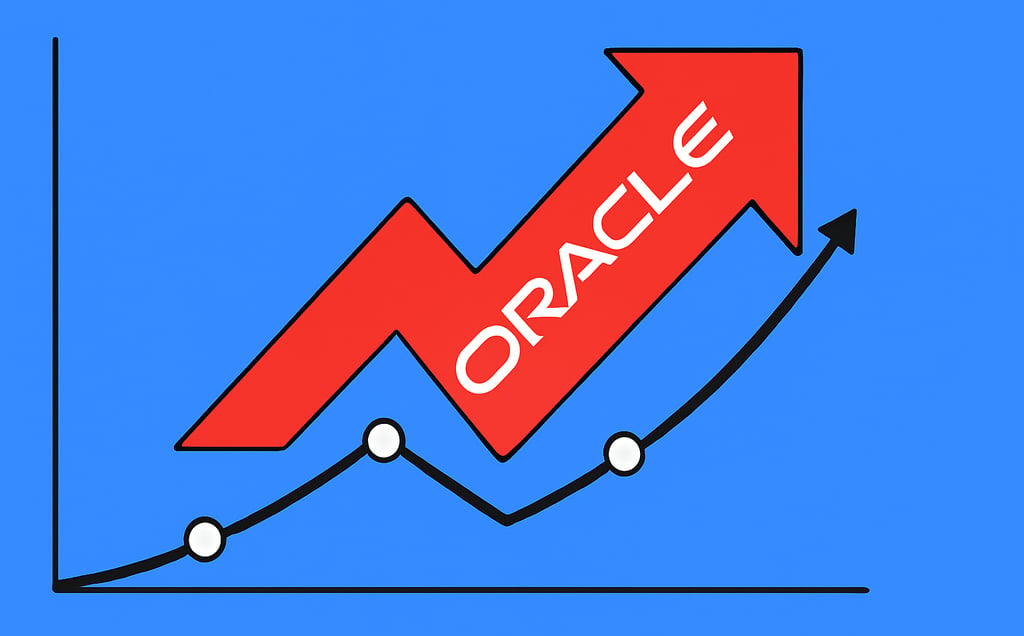Oracle’s Meteoric Rise: What’s Fueling the Surge (and What’s Next)
My take on Oracle’s Meteoric Rise: What’s Fueling the Surge (and What’s Next):
TECHNOLOGYFINANCENEWS
9/22/20252 min read


When a well-established company suddenly spikes 30-40%+ in stock value, it’s more than market hype. Oracle (NASDAQ: ORCL), historically known for its robust database and enterprise software suite, has in the past weeks become one of the most closely watched players in AI infrastructure. For professionals reading this: the present moves in ORCL reveal a pivot point in cloud + AI demand.
History
Oracle Corporation was founded in 1977 by Larry Ellison, Bob Miner, and Ed Oates as Software Development Laboratories (SDL), later renamed Relational Software, then Oracle Systems, and finally Oracle Corporation. Its early strength was database technology and enterprise software—Oracle Database, ERP suites, middleware, etc. Today, its business spans enterprise software, cloud infrastructure (OCI), AI infrastructure, and consulting (https://www.fundinguniverse.com/company-histories/oracle-corporation-history/).
Key points:
It became publicly traded in 1986.
It’s built via both organic R&D and aggressive acquisitions (NetSuite among the biggest) to extend its cloud, ERP, and enterprise software footprint.
Why Oracle Stock has Skyrocketed
Four tailwinds have come together:
Huge AI-Cloud Contracts & Backlog Gains Oracle announced multiple multibillion-dollar contracts, including a reported ~$300 billion five-year deal with OpenAI (Project Stargate), which anchors demand for Oracle’s cloud infrastructure. The company’s backlog of “remaining performance obligations” (RPO) has surged ~359% year over year (https://www.reuters.com/business/oracle-soars-ai-cloud-gains-ellison-closes-musk-worlds-richest-2025-09-10/?utm_source=chatgpt.com).
Demand from AI Infrastructure Firms building, training, and deploying large language models, generative AI systems, etc., are hungry for cloud compute, GPUs, and stable infrastructure. Oracle is capitalizing on that gap, especially versus incumbents that struggle with supply constraints (http://markets.businessinsider.com/).
Regulatory & Geopolitical Opportunities A recent report tied Oracle to a consortium that may enable TikTok to continue operations in the U.S. under a new framework agreement—this kind of regulatory leverage adds speculative premium. Also, national security and data sovereignty are pushing enterprises/government clients toward more compliant infrastructure providers.
Valuation Multiple Expansion Analysts have raised price targets sharply (some to ~$360) and forecast strong revenue growth, especially in OCI. The market is pricing in that Oracle will scale AI cloud faster than many expected.
Where Oracle Seems to Be Heading
Expanding data center footprint and AI-ready infrastructure (more GPU / AI-accelerated compute).
More strategic partnerships (OpenAI, Clean Energy firms like Bloom Energy) to support both the infrastructure demand and sustainability considerations.
Potential margin pressures: AI infrastructure is capital intensive, so Oracle will need to balance CapEx vs profitability.
Competitive pressure from Microsoft Azure, AWS, Google Cloud remains real; Oracle must continue to differentiate on cost, performance, and regulatory compliance.
Credible Quote
“Oracle’s stock surged approximately 43% … This AI-driven demand significantly boosted Oracle’s valuation by about $234 billion.” Reuters
Ismaeel’s Take
Oracle is proving that legacy doesn’t mean stagnation. Its recent surge shows what happens when a long-standing enterprise player leans hard into AI and cloud infrastructure, underpinned by real contracts and backlog—not just promises. For tech/finance professionals, Oracle’s trajectory is a case study in executing for future AI demand, while managing growth risk.
Why AI Literacy + Following Resources Matter
To understand these kinds of moves, you need more than financial statements—you need AI literacy: what AI contracts mean, what infrastructure costs are, and how geopolitics/regulation catch up with tech. Anyone in tech, finance, or strategy roles should stay plugged into resources (analyst reports, regulatory filings, AI-infrastructure news) to see where value is truly being created.
Connect
Engaging digital strategies for your success.
Innovate
Inspire
© 2025. All rights reserved.